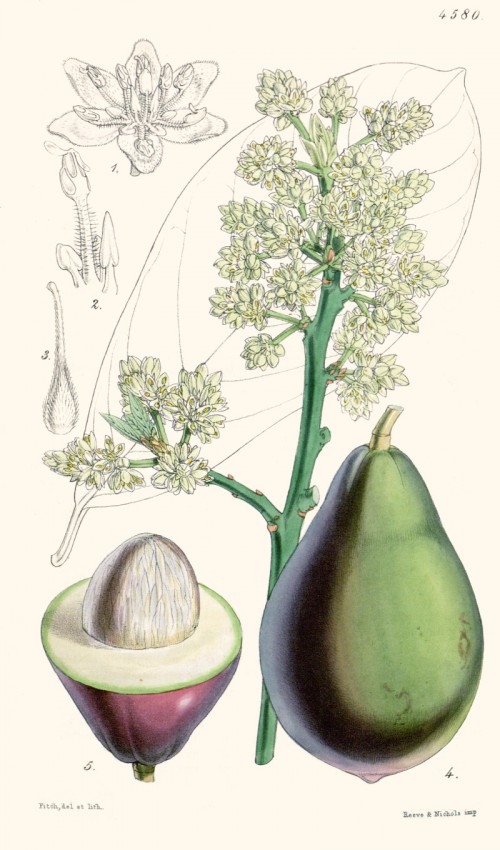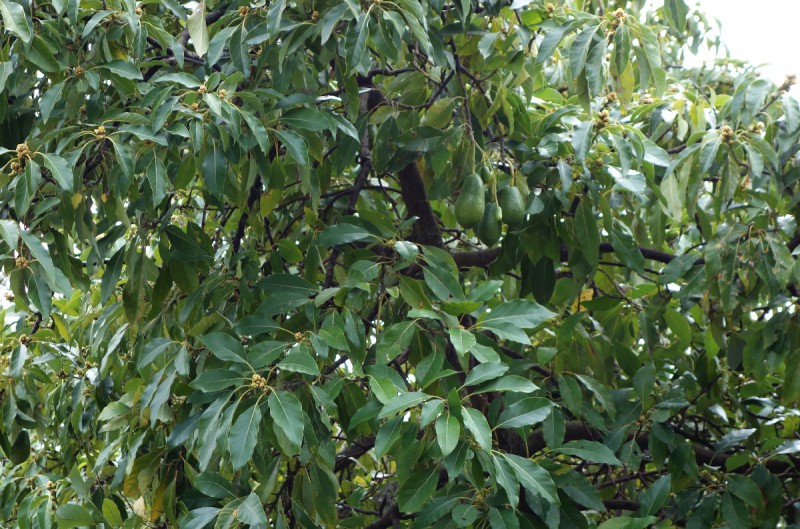Persea americana Mill. - syn. Laurus persea L. - Lauraceae - avocado, alligator-pear , aguacate (span.), Avocado, Butterbirne
Evergreen tree, native to Central America, naturalized and cultivated elsewhere; leaves alternate, glaucous abaxially, green adaxially, narrowly elliptic, elliptic, ovate, or obovate, leathery; flowers tiny (5-6mm), greenish-yellow; fruit pear-shaped, yellow-green, dark green or reddish brown, 8-18cm long.
http://www.efloras.org/florataxon.aspx?flora_id=2&taxon_id=200009046
Persea drymifolia Schltdl. & Cham. = Persea americana Mexican race
Persea gratissima C. F. Gaertn. = Persea americana West Indian race
Persea americana var. guatemalensis [nom. inval.] = Persea americana Guatemalan race
http://www.ars-grin.gov/cgi-bin/npgs/html/taxon.pl?27393
„The majority of the avocados grown in the West Indies, Bahamas and Bermuda and the tropics of the Old World are still of the West Indian race. The skin is leathery, pliable, non-granular, and the flesh low in oil. The leaves are not aromatic.“
[Morton, J. 1987. Avocado. p. 91–102. In: Fruits of warm climates. Julia F. Morton, Miami, FL.] https://hort.purdue.edu/newcrop/morton/avocado_ars.html
„Generally, avocado is served raw, though some cultivars, including the common 'Hass', can be cooked for a short time without becoming bitter. Caution should be used when cooking with untested cultivars; the flesh of some avocados may be rendered inedible by heat.“ https://en.wikipedia.org/wiki/Avocado
Heating of avocado pulp may result in bitterness via synthesis of 1,2,4-trihydroxy-n-heptadeca-16-ene and 1-acetoxy-2,4-dihydroxy-n-heptadeca-16-ene.
[Compounds contributing to heat-induced bitter off-flavor in avocado., Ben‐Et, G., Dolev, A., Tatarsky, D., Journal of Food Science, 38(3), 1973, 546-547]
„Volatile constituents of avocado mesocarp were isolated by concurrent steam distillation/solvent extraction in the Likens-Nickerson apparatus using pentaneether as solvent. The extracts which resulted were concentrated in a Kuderna-Danish concentrator and analysed using gas chromatography and linked gas chromatography-mass spectroscopy (GC-MS) employing capillary columns of contrasting polarity. Hydrocarbons (mainly sesquiterpenes) and alkanals were the predominant constituents present. In the immediate extract of the avocado mesocarp, β-caryophyllene (60%) was the main sesquiterpene, followed by α-humulene (5.9%), caryophyllene oxide (4.8%), α-copaene (4.5%) and α-cubebene as the main hydrocarbons; alkanals were present, but only in low concentrations. In the extract prepared following storage (2h) of the mesocarp at room temperature, β-caryophylene (28.8%) was the main sesquiterpene, followed by β-copaene (10.7%), a cadinene isomer (8.5%), α- and β-cubebene (7.7%), α-farnesene (5.3%) and octane (4.8%) as principal hydrocarbons; decenal (6.3%) and heptenal (3.2%) were the main aldehydes.“
[ Volatiles of avocado fruit. Food chemistry, Sinyinda, S. G., Gramshaw, J. W., Vol.62(4), 1998, 483-487]
„A total of 43 components were identified in avocado aroma including; terpenes (15), esters (8), aldehydes (8), alcohols (6), ketones (2), thiazoles (1), pyridines (1), toluene and acetic acid,… Ethanol, (Z)-3-hexenol and (E)-2-hexenal were the major constituents in green and ripe fruits of avocado whereas they decreased at the final stage of maturation. Over ripe avocado fruits had the highest content of esters (ethyl ethanoate, ethyl acetate and methyl propanoate) and terpenoides especially D-limonene and (Z)-nerolidol.“
[Development of volatile compounds of avocado and casimiroa during fruit maturation., El-Mageed, M. A. A., Arab Universities Journal of Agricultural Sciences, Vol.15(1), 2007, 89-100]
„Changes in aroma volatiles were determined using solid phase microextraction (SPME) and gas chromatography/mass spectrometry in ripe avocados (Persea americana Mill., cv. Hass) throughout an eight-month maturation period and related to the sensory properties of the fruit. As maturation progressed sensory panelists found the likeability of the fruit to increase, coinciding with the fruit becoming creamier and less watery in texture, and the flavor richer and less grassy. During this maturation time the concentration of hexanal, (E)-2-hexenal and 2,4-hexadienal, three of the most abundant volatiles, greatly declined in amount. These volatiles all have a grass-like aroma, and it is likely that the loss in amount was responsible for the decline in grassy flavor during maturation. Acetaldehyde, methyl acetate, pentanal, and β-myrcene were at higher concentrations in mature than non-mature fruit and may also have contributed to the overall flavor. Avocados of an intermediate maturity were ripened at 20 °C and fruit of different ripeness levels (firmnesses) measured for ethylene production, rate of respiration and aroma volatile content. A sharp increase in the rates of respiration and ethylene production marked a rapid increase in softening and the beginning of the climacteric. Twenty-five volatiles were identified in the ripening avocados of which three (pentanol, hexanol, and 2-nonenal) were not detectable in fully-ripe fruit. Of particular interest was an 85% decline in the amount of hexanal in a comparison of firm to fully ripe (4 N firmness) fruit. Aroma volatiles have in the past been little-studied in avocados but appear to have a role in determining the flavor of the fruit.“
[Influence of maturity and ripening on aroma volatiles and flavor in ‘Hass’ avocado., Obenland, D., Collin, S., Sievert, J., Negm, F., Arpaia, M. L., Postharvest Biology and Technology, Vol.71, 2012, 41-50]

Curtis’s Botanical Magazine, vol.77 [ser.3, vol.7] t.4580 (1851) [W.H.Fitch]
http://plantgenera.org/species.php?id_species=770243

Avocado tree, Author: Andreas Kraska CC BY-SA 3.0